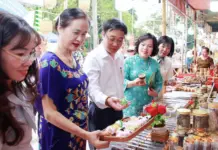| The ethnic Muong live in northern Vietnam’s mountainous region, mostly in Hoa Binh province and some districts of central Thanh Hoa province. The population is over 1.2 million. |
Visiting a Muong hamlet, visitors can see houses-on-stilt built in spacious places and convenient for the daily activities. Normally in a house, there are two kitchens, located in two different places which are suited to the local climate and the owner’s lifestyle customs. The kitchens are cultural spaces unique in both material and spiritual meaning, and preserved by generations of the family members.
The two kitchens are built almost the same in structure, but each has its own function. A kitchen placed in the inner apartment, called the “Women’s kitchen”, is used to cook meals for the family, while the other smaller one, called “Men’s kitchen”, is placed in an outer room near the staircases, where the male members often sit and receive visitors.
Muong people consider the kitchens as sacred places in their spiritual life. When their house is finished, they will begin to build the big kitchen first. From early morning, necessary steps are prepared for the kitchen-building rituals. Banana trees are collected, and the tree bark is peeled off to be laid on the kitchen floor. Banana tree bark due to its low heat-conducting effect, is used as insulation between the kitchen floor and the house floor, and for fire protection.
Trays of worshipping items are arranged, including one food tray to offer to the house owner’s ancestors and the witch-doctor’s masters. Another food tray is offered to the Kitchen God and the Land God who protects the entire locality.
|
Banana tree bark is peeled off to place on the kitchen floor. Photo: Tran Thanh Giang Fresh banana tree bark is used to place on the kitchen floor. They are bad heat-conducting items, hence they work as heat insulators between the kitchen floor and the house floor, against fire. Photo: Tran Thanh Giang After building the kitchen floor, earth is poured over it. Photo: Tran Thanh Giang When the “good time” comes, the witch-doctor, on behalf of the house owner, prays to the ancestors, the Kitchen God and the Land God, and asks for their permission to build the kitchen before living in the house. Photo: Tran Thanh Giang Construction of the kitchen is managed by a prestigious man in the community. He will count the number of baskets of soil put on the kitchen floor, with the last basket being an odd number. Photo: Tran Thanh Giang When construction of the kitchen is underway,worshipping items are prepared. Photo: Tran Thanh Giang Food and workshing items are offered tpthe house owner’s ancestors and the witch-doctor’s masters. Photo: Tran Thanh Giang Food and wineis to offer to the Kitchen God and the Land God who supervise the locality. Photo: Tran Thanh Giang The witch-doctor holds rituals when the soil is poured on the kitchen floor. Photo: Tran Thanh Giang In the kitchen of the Muong, there is an iron tripod, there are three stones forming another triangle and representing three Kitchen Gods. Photo: Tran Thanh Giang When the big kitchen (Women’s kitchen) is complete, another smaller kitchen (Men’s kitchen) will be built. Photo: Tran Thanh Giang |
|
“Construction of the kitchens in the house-on-stilts must begin on a good day and at a good time. Even when the house is not yet completed, the Muong will still build the kitchen if they find a good day. The custom to build the kitchen comes from the ritual to worship the Fire God, which has existed since long ago in the Muong’s life”.
(Bui Huy Vong, from Hoa Binh Province’s Folklore Association) |
When the “good time” comes, the witch-doctor, on behalf of the family owner, prays to the ancestors, the Kitchen God and the Land God, to allow the family members to build a new kitchen. Only when there is permission from the witch-doctor will construction begin.
The big kitchen, or the “Women’s kitchen”, will be built first. Banana tree bark will be placed on the floor as insulation to make the kitchen floor. Then soil will be covered over it. The soil is chosen carefully, taken from deep under the ground, as the hard soil will have no tree roots, is less organic, and will protect against fire better. The Muong think that the soil near the ground will not be clean, as there are dirty mixtures, while the soil deep underground will be pure and clean.
A prestigious man in the community is selected to manage construction of the kitchen. He must have both sons and daughters, who are doing business very well, which is believed to bring good luck to the kitchen’s owner. The manager stands nearby, counting the number of baskets of soil filling the kitchen floor until the last one, which must be an odd number.
In the kitchen, there must be three stones representing three Kitchen Gods. The manager kindles the kitchen fire, saying congratulations to the house owner and wishing him to always have full baskets of rice, good wine, many poultry and pigs, and his children to grow up healthy and become rich. When the fire is full enough, the house owner will grill a fish, which represents the underwater world and also good luck. The Muong always choose grilled fish to pray for good luck coming to their house and family. When construction of the kitchen is complete, the house owner will light a fire immediately, and keep the fire going for three consecutive days and nights. The fire doesn’t have to be at full force, just enough to warm up the kitchen. Doing it that way, the house owner reports to the Heaven and the Earth, and his villagers that his new house was just built.
When construction of the big kitchen is complete, the house owner will build the smaller one, with the same steps taken. However, about one-third of the last basket of soil will be spilled out of the kitchen, which means, the house owner gives back some luck to other people.
|
The manager of the kitchen construction, kindles the fireplace, with congratulations to the house owner and wishing him to have full baskets of rice, good wine, poultry and pigs and children growing up healthy and doing business well. Photo: Tran Thanh Giang When the fire is on, the house owner will grill fish, which represents the underwater world and also good luck. Photo: Tran Thanh Giang The witch-doctor reads prayers with wishes for the house owner and his family to have good health, good luck and a peaceful life. Photo: Tran Thanh Giang The manager of the kitchen construction lights a fire in the fireplace with congratulations to the house owner. Photo: Tran Thanh Giang To abolish bad luck, white silk is hanging all over in the new house. After doing worshipping rituals, the witch-doctor will cut off all the silk with the hope that relations between the building materials and bad luck will go away from the house, making the house exist in peace and happiness with the owner and his family. Photo: Tran Thanh Giang Final rituals processed by the witch-doctor for the new kitchen. Photo: Tran Thanh Giang With respect for the fireplace, the ethnic Muong people express their lifestyle of solidarity, fine culture and friendliness, which has been preserved since long ago. Photo: Tran Thanh Giang |
According to the Muong’s thinking, their house-on-stilt is made of timber and bamboo trees, which may bring bad luck to the house owner and his family. The bad things are described by white silk hanging over every corner of the new house. When the witch-doctor finishes his ceremonial rituals, he will cut off all the white silk, meaning to cut all ties between the building materials with their growing place, hence all the bad things will go away, and the house will exist in peace and good luck with the family members. It is also the last ritual processed by the witch-doctor for kitchen building.
Since long ago, the Muong people have lived in close touch with the fireplace, where they not only can cook food, but also get light and warmth at night, and be protected from dangerous animals. The Muong people’s respect for the fireplace manifests their long-standing culture, solidarity and friendliness, which has been preserved for a long time.



